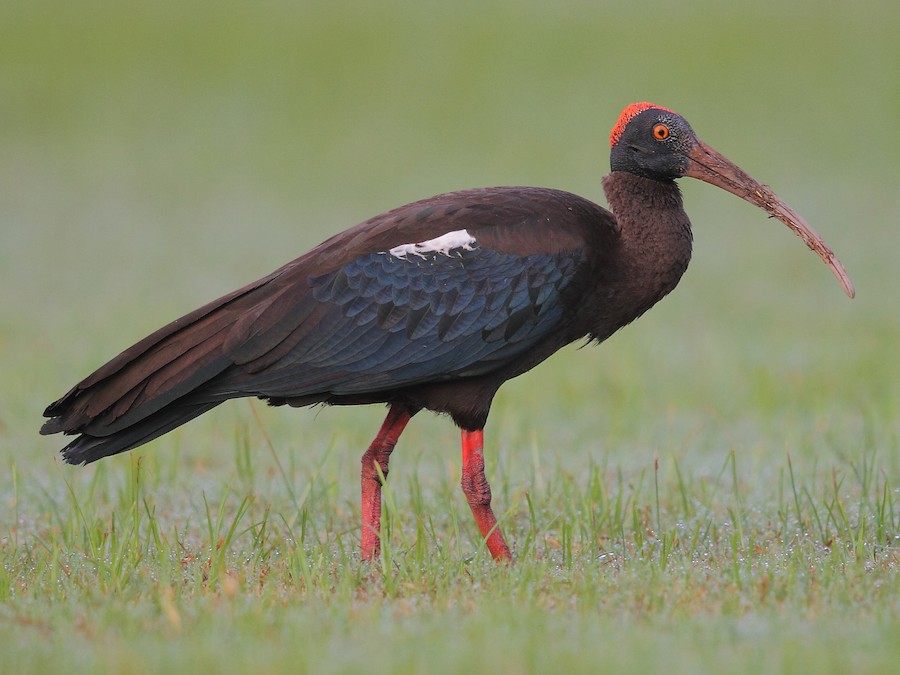
Red-naped Ibis
Pseudibis papillosa
Order:
Family:
Size:
70 to 80 centimeters (27.5 to 31.5 inches)
Weight:
1.8 to 2.5 kilograms (4 to 5.5 pounds)
Taxonomy:
Edward Blyth in 1846
Short Description:
The red-naped ibis (Pseudibis papillosa) also known as the Indian black ibis or black ibis is a species of ibis found in the plains of the Indian Subcontinent. Unlike other ibises in the region it is not very dependent on water and is often found in dry fields a good distance away from water. It is usually seen in loose groups and can be told by the nearly all dark body with a white patch on the shoulder and a bare dark head with a patch of crimson red warty skin on the crown and nape. It has a loud call and is noisy when breeding. It builds its nest most often on the top of a large tree or palm. The red-naped ibis is a large black bird with long legs and a long downcurved bill. The wing feathers and tail are black with blue-green gloss while the neck and body are brown and without gloss. A white patch on the shoulders stands out and the top of the featherless head is a patch of bright red warty skin. The warty patch, technically a caruncle, is a triangular patch with the apex at the crown and the base of the triangle behind the nape that develops in adult birds. The iris is orange-red. Both sexes are identical and young birds are browner and initially, lack the bare head and crown. The bills and legs are grey but turn reddish during the breeding season. The toes have a fringing membrane and are slightly webbed at the base. They are usually silent but call at dawn and dusk and more often when nesting. The calls are a series of loud braying, squealing screams that descend in loudness. The red-naped ibis is omnivorous, feeding on carrion, insects, frogs, and other small vertebrates as well as grain. They forage mainly in dry open land and stubbly fields, sometimes joining egrets and other birds on land being tilled to feed on disturbed insects and exposed beetle grub. They walk and like other tactile-feeding ibises, probe in the soft ground. The rarely wade in water[6] but have been observed seeking out frogs hiding in crab holes. They sometimes feed at garbage dumps. During droughts, they are known to feed on carrion and insect larvae feeding on meat. They also feed on groundnut and other crops. In British India, indigo planters considered them useful as they appeared to consume a large number of crickets in the fields. Red Naped Ibis is rare non breeding moonsoon visitor to freshwater wetlands in East Nara, Indus Delta and Lower sind. Often forages in dry cultivation. Two recent records from Punjab, one from Sialkot and one from Jahanian.
Far far away, behind the word mountains, far from the countries Vokalia and Consonantia, there live the blind texts. Separated they live in Bookmarksgrove right at the coast
Khanewal,Sialkot,Badin,Hyderabad,Karachi Central,Khairpur,Sanghar,Tharparkar,Karachi East
Red-naped Ibises are predominantly diurnal birds, meaning they are active during the day. They are often observed foraging in shallow water, probing the mud with their bills in search of prey such as insects, crustaceans, small fish, and amphibians. They may also feed on land, searching for insects and other invertebrates in grassy areas.
Far far away, behind the word mountains, far from the countries Vokalia and Consonantia, there live the blind texts. Separated they live in Bookmarksgrove right at the coast
About Photographer : Hello World
Facebook
Twitter
Instagram
Flicker
LinkedIn

